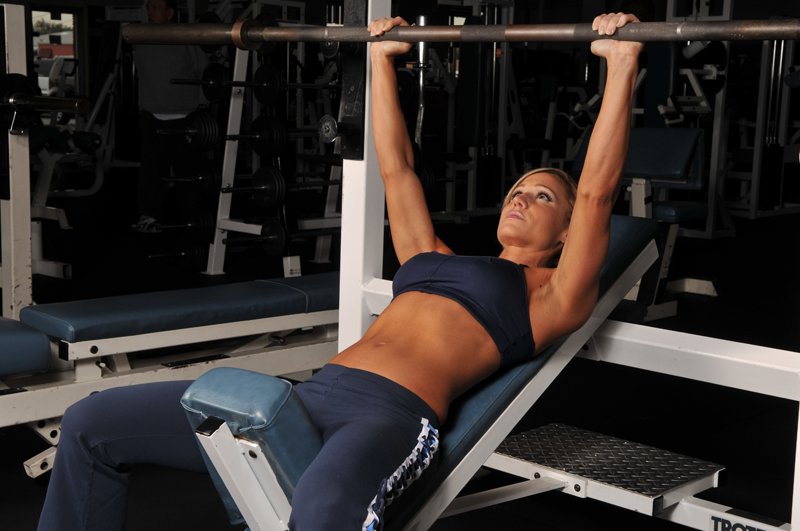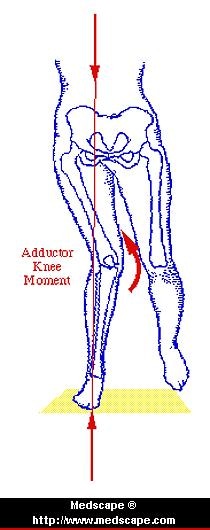Fun fact for you; women have ten to twenty times less testosterone than men. Testosterone is the male sex hormone responsible for facial hair, deeper voices, external genitals, muscle growth, and building society (that's a totally different topic all together). This means that women will not put on muscle mass at anywhere near the same rate as men. For every ten pounds of muscle that a man gains a similar women will only gain two to three, if any. Women get bulky when they use/abuse exogenous androgens, i.e. anabolic steroids. In fact, many women have less muscle than they actually think. It's the fat on top that makes them look bulky. Let's say the average woman weighs 140 pounds. That women will carry anywhere from 17%-25% of that weight as adipose tissue (fat). This mean that she really only has 101 to 117 pounds of lean body mass, which also includes bone, mineral deposits, and water on top of muscle. Needless to say, you gals could stand a little more muscle tissue.
 |
| Maybe too much muscle? |
For many women trainees goal numero uno is weight loss. More specifically fat loss. When on a fat loss plan scale weight is secondary to the results you get in the mirror or with the skinfold calipers (body fat measuring device). One of the best ways to enhance your fat loss efforts is to perform training sessions that increase your post exercise calorie burn. known as EPOC (Excess post-exercise oxygen consumption). What's the best way to increase your EPOC? You can bet your bottom dollar it's medium- to high-intensity resistance training. In fact, low intensity steady state exercise is right next to useless if you want to keep your metabolism elevated post exercise. The reason being is that resistance training really knocks your body out of homeostasis (balance). You break down tissue, release certain hormones, and use large amounts of fuel during resistance training. In order for your body to return to balance your body needs to burn energy. So while the cross trainer says you burned 450 calories in an hour (this is usually inaccurate anyways) that's all your going to burn. Throw some iron around for an hour and you burn a lot more than that. Not to mention put on some much needed muscle, which brings me to my next fat loss point.
The more muscle you carry the higher your metabolism. Muscle is what is known as "metabolically active tissue". Fat is not. Muscle goes for walks, does push ups in its spare time, and thinks critically about the important issues of the day. Fat sits on the couch, takes frequent cat naps, and never has an original thought. Carry around a few extra pounds of muscle and you've got yourself a fat burning furnace that requires calories 24-fucking-7.
On top of strength training's muscle tissue enhancing effects it also plays a major role in building and maintaining bone density. In fact, a number of studies have shown that aerobic exercise is also right next to useless in maintaining bone density. Take that runners. Secondary to bone health is the fact that resistance training also increases one's balance and proprioception (knowing where you are in space). So when you're 80 and you step down from a curb you will be less likely to break a hip and fall (more common) and less likely to just fall and then break an arm or hip or whatever.
The more muscle you carry the higher your metabolism. Muscle is what is known as "metabolically active tissue". Fat is not. Muscle goes for walks, does push ups in its spare time, and thinks critically about the important issues of the day. Fat sits on the couch, takes frequent cat naps, and never has an original thought. Carry around a few extra pounds of muscle and you've got yourself a fat burning furnace that requires calories 24-fucking-7.
On top of strength training's muscle tissue enhancing effects it also plays a major role in building and maintaining bone density. In fact, a number of studies have shown that aerobic exercise is also right next to useless in maintaining bone density. Take that runners. Secondary to bone health is the fact that resistance training also increases one's balance and proprioception (knowing where you are in space). So when you're 80 and you step down from a curb you will be less likely to break a hip and fall (more common) and less likely to just fall and then break an arm or hip or whatever.
 |
| Am I going to hell for laughing at this? |
Now let's move into the arena of female athletics. Anatomically there is very little difference between men and women. The biggest difference and most important revolve around the hips. If you've ever given birth you are thankful that you and your like evolved wider hips to pass the head of the baby through. This creates, however, some interesting angles when it comes to the femur and the knee. Since the hips are wider apart there is more of a tendency for a woman's knees to fall inward in what is called valgus knee angle.
On top of that women have a higher tendency to be quad dominant. This takes the hamstring out of movement patterns that require deceleration, stopping, and changing direction. Couple quad dominance and a valgus knee/hip angle and you've gotten a recipe for ACL tears. A study done at Marquette University looked at the effects of a six-week lower body training schedule that prioritized hamstring development. In the end the study subjects had a better quad to hamstring strength ratio. The authors concluded that hamstring prioritization may help increase knee stability and reduce injury rates in women. You hear that female athletes? I few well spent hours in the weight room and you can avoid nine months of post-ACL rehab. But what's the best way to go about it?
 |
| When I go to hell I'm going to be forced to be the guy on the ball. |
Squats and deadlifts work your ass, hips, thighs, hamstrings, and abdomen like no other exercises can. Presses, rows, and chin ups build strong and lean upper bodies. These exercises have been around since forever and will never go out of style. Just do them. You'll thank me.
These exercises should be performed with a relatively moderate to heavy weight for low to moderate reps. The key word there is "relatively". There is no X amount of weight that a women should be able to move on any given lift. Again, heavy weights don't equal bulky physiques. In a study done on women only, researchers had women perform high rep/low weight bicep curls on one arm and low rep/heavy weight bicep curls on the other. There was no significant difference in muscle size at the end of the study. There was, however, a significant increase in maximal strength on the side that performed the low rep/high weight exercise. Also, women who can move heavy weights and do a chin up are far more awesome and much more prepared to pass on favorable genetic traits than women who don't. Fact.
 |
| Fact. |
- Women will only get bulky with the aid of anabolic steroids or a shitty diet and no exercise.
- Strength training is much better for fat loss than cardio.
- Strength training is far better at maintaining bone density than aerobic exercise.
- If you are an athlete you have to train your hamstrings and hips.
- Women can and should do all the exercises men do with weights that are relatively heavy for them.
- If you don't train with weights you will either be fat, frumpy, skinny-fat, or Skeletor skinny. None of these are good.
Sources:
Layne JE, Nelson ME. The effects of progressive resistance training on bone density: a review. Med Sci Sports Exerc. 1999 Jan;31(1):25-30.
Guadalupe-Grau A, Fuentes T, Guerra B, Calbet JA. Exercise and bone mass in adults. Sports Med. 2009;39(6):439-68.
Børsheim E, Bahr R. Effect of exercise intensity, duration and mode on post-exercise oxygen consumption.
Sports Med. 2003;33(14):1037-60.
http://www.bodybuilding.com/fun/berardi12.htm
http://articles.elitefts.com/articles/training-articles/considerations-for-training-females/
http://www.t-nation.com/free_online_article/sports_body_training_performance_investigative/cuttingedge_muscle_science
http://articles.elitefts.com/articles/training-articles/what-women-should-never-do-but-often-do-while-trying-to-get-in-shape-part-1-of-6/

some hot shit right hur.
ReplyDelete